Handmade furniture costs more because it’s crafted with exceptional skill, using high-quality, sustainable materials. The process takes much longer, often days or weeks, requiring expert labor that’s hard to scale. Each piece is unique, durable, and tells a story, unlike mass-produced options. Plus, artisans focus on sustainability and ethical sourcing. Wondering why these qualities come with a higher price? Keep exploring to discover the true value behind artisanal craftsmanship.
Key Takeaways
- Handmade furniture involves longer, labor-intensive processes that require skilled artisans, increasing production costs.
- Use of high-quality, sustainable materials and traditional techniques enhances durability and uniqueness, raising prices.
- Artisanal pieces are limited in quantity, emphasizing exclusivity and craftsmanship over mass-market affordability.
- Unique imperfections and artistic expression add value, making each piece a distinctive work of art.
- The emphasis on quality, customization, and cultural significance drives higher prices compared to mass-produced options.
The Craftsmanship Behind Handmade Furniture
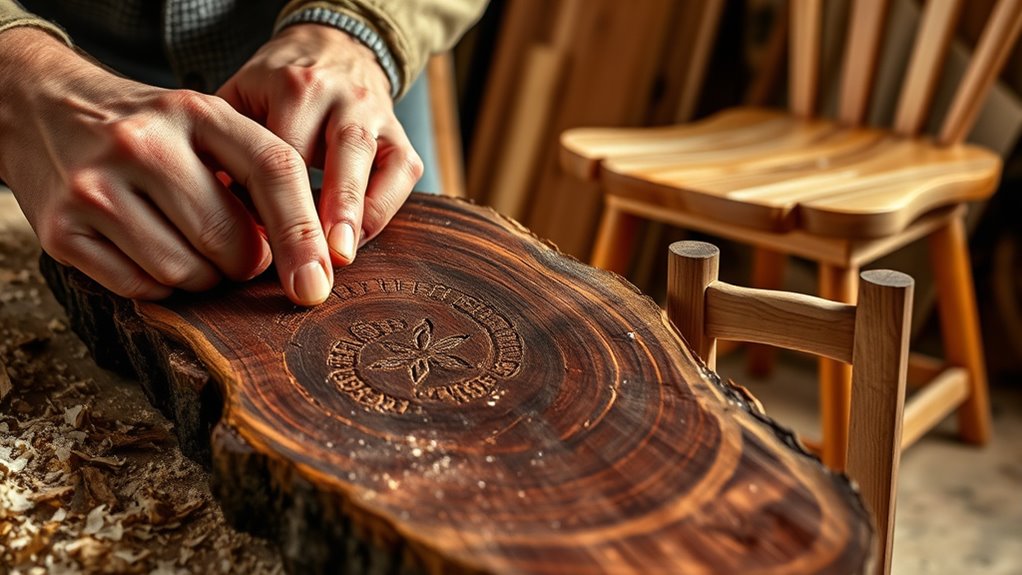
Handmade furniture stands out because of the skill and attention to detail that artisans put into every piece. Unlike mass production, where factory efficiency prioritizes speed and quantity, craftsmanship focuses on quality and precision. Artisans take the time to carefully craft each component, ensuring durability and aesthetic appeal. This meticulous process often involves hand tools and traditional techniques that mass production simply can’t replicate. While factories aim for uniformity and rapid output, artisans embrace imperfections as part of their unique touch. Your handcrafted piece reflects the dedication and expertise of its maker, resulting in furniture that’s not only functional but also a work of art. Additionally, the energetic alignment of artisans with their craft often results in pieces that resonate with positive energy, adding an intangible value to each creation. The cultural significance embedded in handmade furniture further elevates its worth, connecting the piece to local traditions and history. The use of traditional techniques ensures that each piece carries the authenticity and heritage of the craft, making it more than just furniture but a storytelling artifact. This careful craftsmanship, combined with an understanding of HVAC systems and their importance in creating comfortable living spaces, justifies the higher price and makes each piece truly special.
Materials and Sourcing in Artisanal Pieces
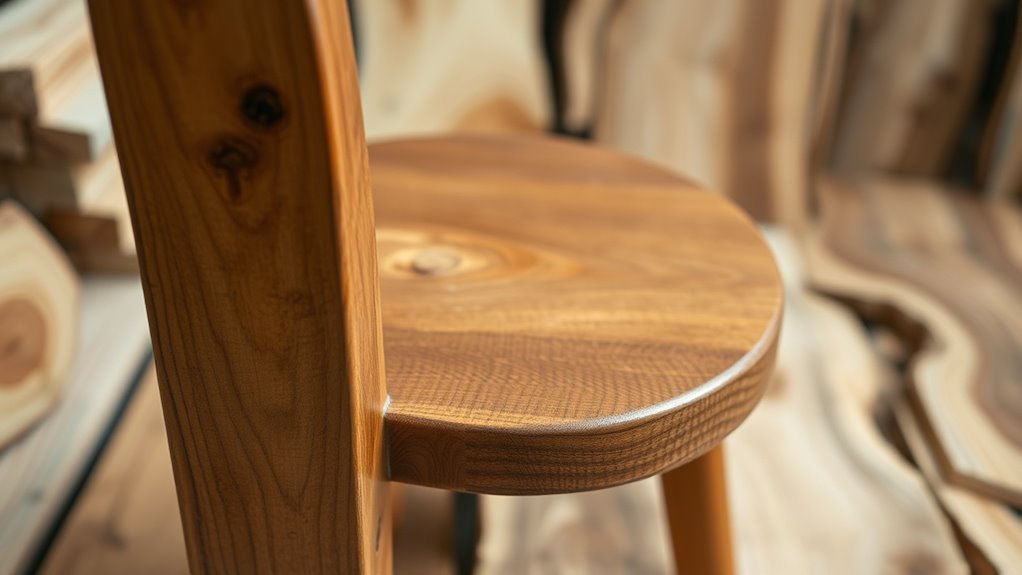
Artisans prioritize sourcing high-quality, sustainable materials to guarantee their furniture stands the test of time. Unlike mass production, they avoid synthetic materials that often compromise durability and environmental health. Instead, they focus on genuine sources:
Artisans choose genuine, sustainable materials to ensure durable, eco-friendly furniture that lasts a lifetime.
- Locally harvested wood—reducing environmental impact and supporting community economies
- Natural finishes—ensuring longevity without harmful chemicals
- Reclaimed or recycled materials—adding character and reducing waste. Incorporating sustainable sourcing practices elevates the value and integrity of artisanal furniture. These choices reflect a commitment to quality and sustainability, which often makes artisanal pieces more expensive. Authentic materials sourcing authentic materials requires time and effort, unlike mass production, where synthetic materials and shortcuts are common. You get furniture that’s not only beautiful but also built with integrity and care, reflecting a dedication to craftsmanship that distinguishes artisanal work from mass-produced items. Additionally, environmentally friendly practices in sourcing further enhance the value and appeal of handmade furniture.
Time and Labor Investment in Handcrafted Items
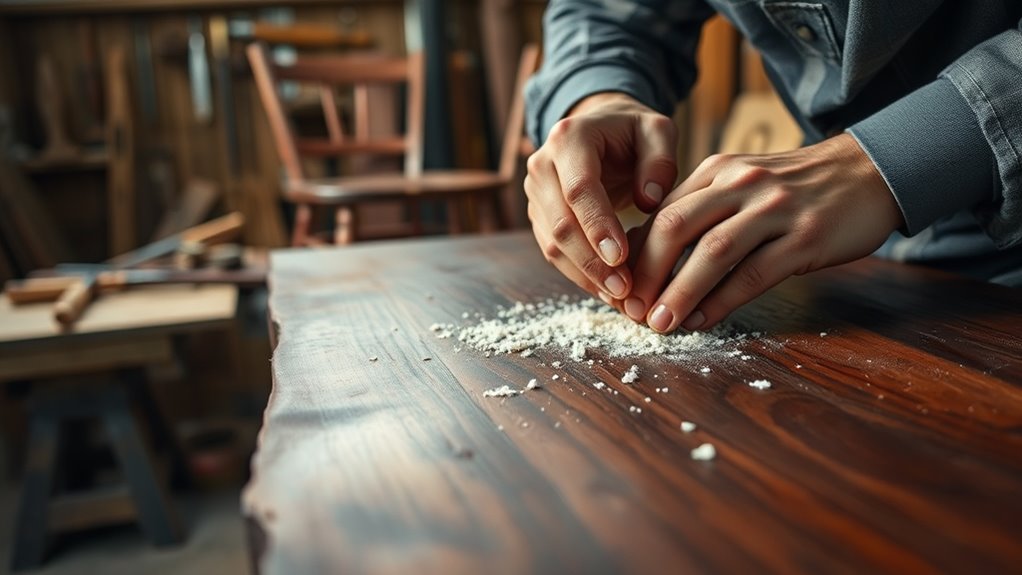
You’ll notice that handcrafted furniture takes much longer to create than mass-produced pieces. Skilled artisans dedicate hours, sometimes days, to perfect each item, requiring intense focus and craftsmanship. This extra time reflects the craftsmanship and effort that go into making every piece unique. Additionally, the attention to detail and meticulous effort involved further justify the higher cost. Recognizing the value of craftsmanship highlights the importance of investing in quality over quantity. Moreover, the holistic healing aspect of handcrafted items often results in pieces that carry more emotional and aesthetic significance, making them truly special investments. The industry demand for handcrafted furniture continues to grow as consumers seek meaningful and durable designs.
Extended Craftsmanship Duration
Creating handcrafted furniture requires a significant investment of time and effort, often taking weeks or even months to complete a single piece. This extended craftsmanship duration directly impacts production speed, making it impossible to match mass-market appeal’s quick turnaround. As a result, you’ll notice three key points:
- The slow process guarantees each piece is meticulously finished, reflecting high quality.
- The longer timeline limits your ability to produce large quantities quickly.
- The dedication to detail increases labor costs, raising overall prices.
- This meticulous process also encourages goal tracking to ensure timely progress and maintain craftsmanship standards. Additionally, the labor-intensive nature of handmade furniture contributes to higher costs compared to mass-produced options. The extended duration also allows artisans to focus on quality assurance, ensuring each piece meets strict standards before reaching the customer. Recognizing the importance of consistent routines helps artisans maintain focus and precision throughout the lengthy crafting process. Furthermore, material selection plays a crucial role in achieving the desired durability and aesthetic, often adding to the time required. While mass-produced furniture prioritizes rapid production for broad appeal, handmade pieces emphasize artistry and durability. Your focus on craftsmanship naturally extends the timeline, which explains why these items command higher prices despite longer wait times.
Skilled Labor Intensity
Handcrafted furniture demands a high level of skill, requiring precise techniques and extensive training. Unlike mass production, which relies on rapid assembly lines, artisans invest significant time and effort into every piece. This skilled labor intensity means each item takes longer to create, as artisans meticulously shape, carve, and assemble components. This level of craftsmanship involves a deep understanding of woodworking techniques, which are often passed down through apprenticeships and specialized training. The craftsmanship involved increases labor costs, which are reflected in the final price. Additionally, skilled workers often use higher-quality materials, contributing to higher material costs. In mass production, materials are typically cheaper and standardized, allowing for quicker, less labor-intensive processes. The combination of expert craftsmanship, the time invested, and superior materials explains why handcrafted furniture costs more—you’re paying for artistry, durability, and the human touch that mass-produced pieces can’t replicate. Furthermore, the skilled labor intensity directly impacts the overall cost, emphasizing the value of handcrafted work. Recognizing the creative practice behind each piece highlights the dedication and expertise that justify its higher price point. The use of specialized techniques further differentiates handcrafted furniture from mass-produced alternatives, adding to its unique value. Moreover, attention to detail in each handcrafted piece ensures a level of quality that mass production cannot easily achieve, reinforcing its premium status.
Unique Designs and One-of-a-Kind Quality

When you choose artisanal furniture, you get pieces that showcase individual artistic expressions, making each item unique. These limited production runs mean no two pieces are exactly alike, adding to their exclusivity. This approach guarantees your furniture stands out with one-of-a-kind character and craftsmanship. Additionally, the high level of craftsmanship quality involved often results in more durable and longer-lasting furniture.
Individual Artistic Expressions
Unlike mass-produced furniture, artisanal pieces often serve as canvases for individual artistic expression, resulting in designs that are truly one-of-a-kind. You’ll notice that each handcrafted item reflects the artisan’s unique style, creativity, and craftsmanship, making it more personal and meaningful. This approach counters the uniformity of factory efficiency and mass production, which prioritize speed over uniqueness.
Consider these points:
- Each piece tells a story—no two are identical.
- The artisan’s skill influences every detail, creating depth and character.
- These designs challenge the notion of perfect symmetry, embracing imperfections that add charm.
This focus on individual expression elevates the value of handmade furniture, making it more than just functional—it’s a work of art.
Limited Production Runs
Limited production runs create furniture that stands out because each piece is carefully designed to be unique. Unlike mass production, which prioritizes scalability, limited runs focus on craftsmanship and distinctiveness. This approach allows artisans to infuse each item with individual character, making it one-of-a-kind. Because these pieces are produced in small quantities, the process demands more time, skill, and attention to detail, which naturally raises costs. Mass production faces scalability challenges when trying to replicate this level of uniqueness, often sacrificing quality for speed. With limited runs, you get furniture that reflects true artistry and rarity, but at a higher price. This exclusivity is what makes handmade furniture special and worth the investment for those seeking originality and craftsmanship.
Durability and Longevity of Handmade Furniture
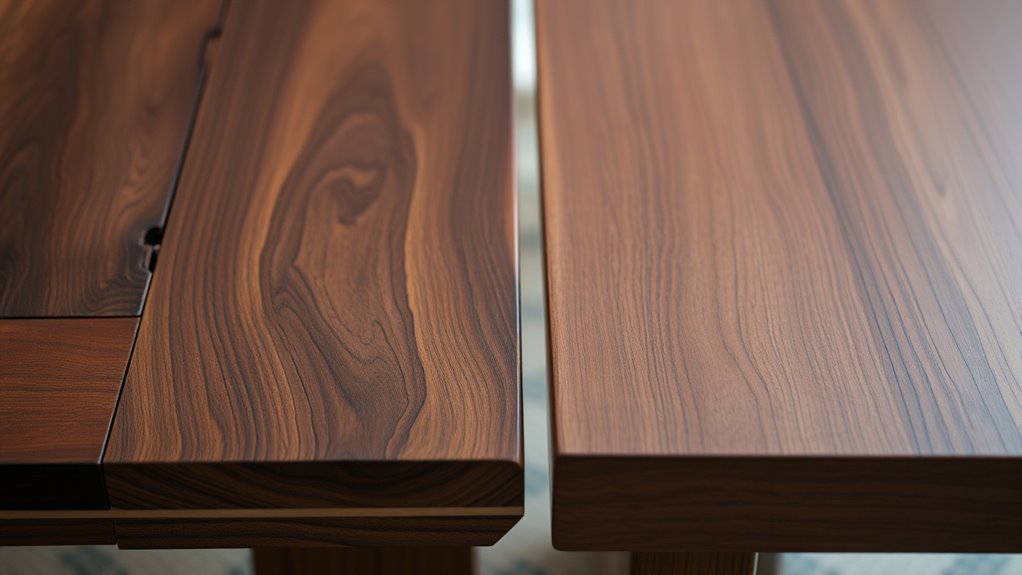
Handmade furniture often stands out for its remarkable durability and longevity, provided it’s crafted with quality materials and skillful techniques. Unlike mass-produced pieces that rely on synthetic materials, artisans select solid wood and natural finishes that age gracefully. To guarantee durability, consider these factors:
- Material Quality: Handmade furniture uses premium, natural materials that resist wear over time.
- Construction Method: Traditional techniques like joinery create stronger joints than glued or nailed mass production methods.
- Maintenance & Care: Proper upkeep extends the lifespan, making it a worthwhile investment.
While synthetic materials in mass production may reduce costs initially, they often compromise longevity. Handmade furniture’s craftsmanship results in pieces that can last decades, even generations, making it a durable choice for your home.
The Role of Skill and Experience of Artisans
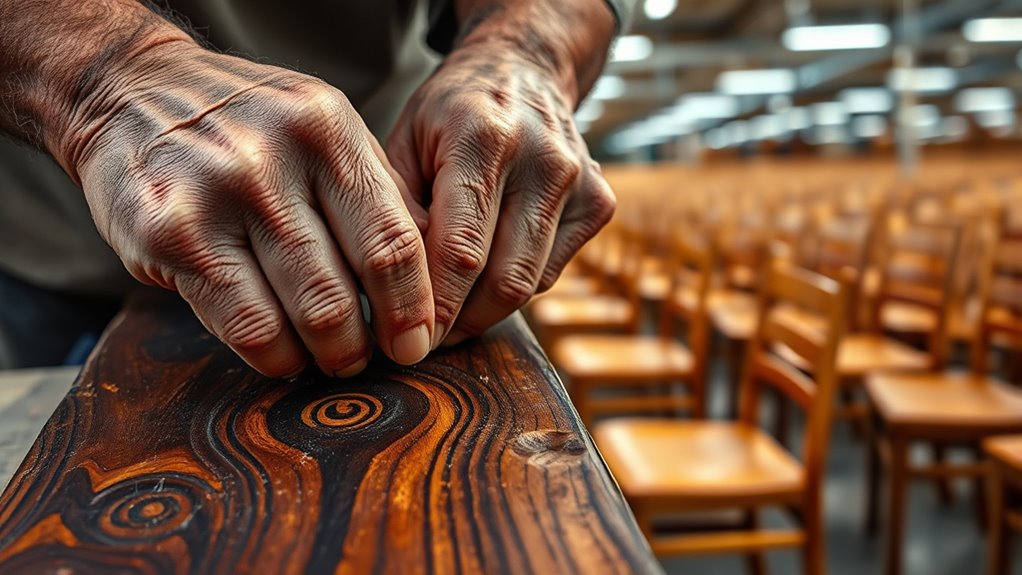
The skill and experience of artisans directly influence the quality and durability of handmade furniture. Unlike mass production, where assembly lines optimize speed over craftsmanship, skilled artisans focus on precise techniques that maximize material efficiency. Their expertise ensures each piece is carefully crafted, reducing waste and enhancing the furniture’s strength. Experience allows artisans to select the best materials, avoid flaws, and execute complex details that machines can’t replicate. This attention to detail results in furniture that’s not only beautiful but built to last. While mass production prioritizes quantity, artisans invest time and knowledge into every item, justifying the higher cost. Your furniture’s quality, durability, and unique character depend heavily on the artisan’s skill and experience.
Production Scale and Its Impact on Cost

When production runs are limited, costs per piece tend to rise because of higher labor intensity and custom work. You might notice that artisanal furniture often involves more hands-on effort, which adds to the expense. This scale also allows for greater customization, but it can make the final price less competitive compared to mass-produced options.
Limited Production Runs
Limited production runs, by focusing on creating a small number of pieces, often lead to higher costs per item. When you opt for limited edition or exclusive collections, each piece demands more attention and craftsmanship, driving up expenses. This approach means:
- Fewer units are produced, reducing economies of scale.
- Each piece is customized or unique, increasing labor and material costs.
- The exclusivity boosts perceived value, allowing higher prices.
Because of these factors, artisans can’t mass produce at low costs, making each item more costly. You’re paying for the rarity, craftsmanship, and uniqueness that come with limited production runs. This approach ensures your furniture stands out as a true work of art, but it also explains why it’s priced higher than mass-produced alternatives.
Higher Labor Intensity
Because artisanal furniture often involves limited production runs, each piece demands more hands-on effort and detailed craftsmanship. Unlike mass production, where assembly lines maximize cost efficiency, artisans spend extra time shaping, finishing, and perfecting each item. This higher labor intensity means that more skilled work is invested in every piece, raising production costs. Mass production benefits from economies of scale, reducing per-unit expenses, but it sacrifices the personal touch and quality control that come with handcrafted furniture. As a result, the increased labor involved in artisanal processes directly impacts the final price, reflecting the time, skill, and attention to detail required. This higher labor intensity explains why handmade furniture tends to cost more than mass-produced alternatives.
Customization Opportunities
Mass production often limits customization options because scaling up involves standardized processes that prioritize efficiency over personalization. This makes it challenging to offer truly personalized options tailored to individual tastes. However, some manufacturers now embrace mass customization, allowing you to select finishes, fabrics, or dimensions. To understand this better, consider these points:
- Larger-scale production often reduces the variety of personalized options available.
- Customization becomes more expensive as each piece requires adjustments outside the standard process.
- Smaller, artisanal operations typically offer more flexible options because they focus on bespoke craftsmanship.
While mass production might limit your customization opportunities, advances in technology are gradually making personalized options more accessible at scale, though often at a higher cost.
Ethical and Sustainable Practices in Artisanal Manufacturing
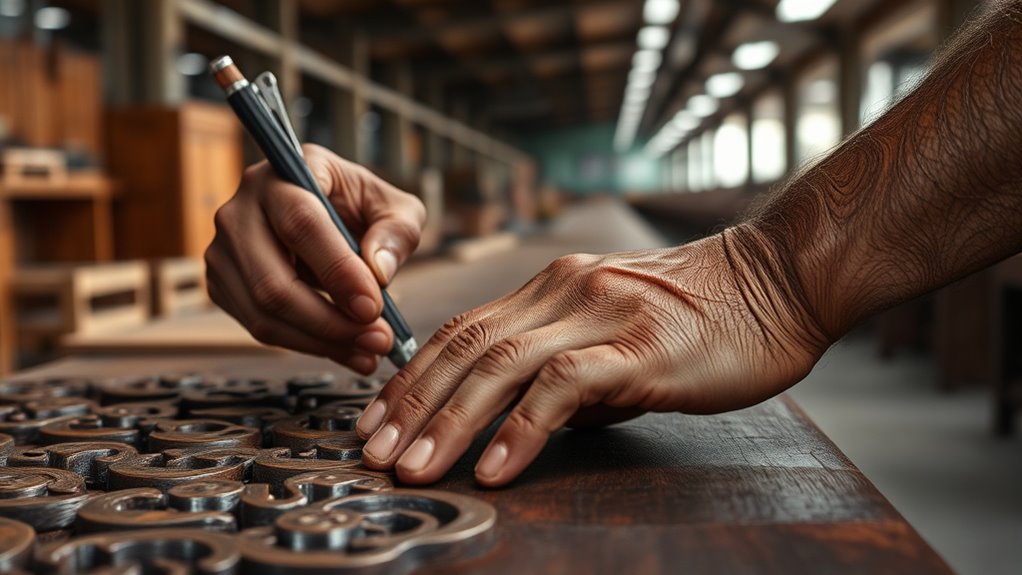
Artisanal manufacturing often emphasizes ethical and sustainable practices that set it apart from mass-produced furniture. You’ll find artisans frequently use recycled materials, reducing waste and lowering environmental impact. These practices guarantee that every piece is crafted with care, prioritizing longevity and responsible sourcing. Unlike mass-market appeal, which often relies on cheap, synthetic materials, handmade furniture tends to focus on eco-friendly options that support local communities and fair labor standards. By choosing artisanal pieces, you support practices that nurture the environment and promote social responsibility. This commitment to sustainability not only benefits the planet but also assures that your furniture is crafted with integrity, reflecting a genuine respect for resources and craftsmanship.
The Emotional and Artistic Value of Handmade Pieces

Handmade furniture carries a unique emotional and artistic resonance that mass-produced pieces often lack. When you choose handcrafted items, you foster a genuine emotional connection that reflects the artisan’s dedication. These pieces embody artistic expression, capturing creativity that machines can’t replicate. Consider these aspects:
- Personal Touch – Every detail reveals the artisan’s skill and passion, making your furniture truly one-of-a-kind.
- Storytelling – Each piece carries a history, connecting you to the craftsmanship and tradition behind it.
- Authenticity – Handmade furniture embodies sincerity and uniqueness, enriching your space with meaningful artistry.
Factors Influencing the Price Difference

Several factors contribute to the higher cost of handcrafted furniture compared to mass-produced options. First, artisans focus on quality craftsmanship, which takes more time and skill, increasing labor costs. Unlike mass market appeal, where items are designed for broad appeal and quick production, handmade pieces often cater to niche tastes, justifying higher prices. Additionally, pricing strategies reflect the exclusivity and uniqueness of each item, making them less about volume and more about value. Materials used in artisanal furniture are usually premium, adding to expenses. Customization options also elevate costs because they demand extra effort and attention to detail. Overall, these elements combine to make artisanal furniture more expensive, emphasizing quality and uniqueness over mass appeal and affordability.
Frequently Asked Questions
How Does the Rarity of a Handmade Piece Affect Its Price?
You’ll find that limited rarity substantially boosts the price of a handmade piece because it highlights its uniqueness and exclusivity. When you own a piece with limited availability, you’re getting a work of art that showcases unique craftsmanship, making it more desirable and valuable. This rarity appeals to collectors and enthusiasts who appreciate the effort and skill involved, ultimately driving up its cost compared to more common, mass-produced furniture.
Are There Health or Environmental Benefits to Choosing Handcrafted Furniture?
Choosing handcrafted furniture offers health and environmental benefits. You use sustainable materials, which reduce environmental impact, and non-toxic finishes that improve indoor air quality. Handcrafted pieces often avoid harmful chemicals found in mass-produced furniture, making them safer for your home and family. By opting for artisanal furniture, you support eco-friendly practices and create a healthier living space, all while enjoying unique, high-quality craftsmanship.
Can Custom Designs Influence the Cost of Artisanal Furniture?
Yes, custom designs can substantially influence the cost of artisanal furniture. When you opt for customization options, artisans spend extra time and skill to meet your specific needs, which increases the price. Design flexibility allows for unique details and personalized finishes, but these added elements require more craftsmanship. Ultimately, your desire for tailored, one-of-a-kind pieces means investing more, reflecting the craftsmanship and individuality behind each handcrafted item.
How Do Artisan Workshops Impact Local Economies?
You help boost local economies by supporting artisan workshops, which strengthen local craftsmanship and foster economic growth. When you buy handmade furniture, you’re not just getting unique, high-quality pieces; you’re also creating jobs and encouraging small business development in your community. Your support sustains traditional skills, keeps craftsmanship alive, and promotes a thriving local economy, making a tangible difference in the area’s overall economic health.
What Maintenance Is Required to Preserve the Quality of Handmade Furniture?
Maintaining your handmade furniture is like tending a delicate garden. You should regularly dust and clean it using gentle cleaning routines to prevent dirt buildup. Applying appropriate finishing techniques, like waxing or sealing, helps protect the wood from moisture and damage. Avoid harsh chemicals, and periodically inspect for cracks or loose joints. With consistent care, your furniture retains its beauty and craftsmanship for generations.
Conclusion
When you choose handmade furniture, you’re investing in artistry that surpasses even the most intricate masterpieces. Every piece carries the soul of a craftsman’s passion, making it priceless beyond measure. While mass-produced items may seem affordable, they lack the magic and durability of true craftsmanship. In the end, your decision to buy artisanal affirms you’re embracing a timeless treasure that stands as a demonstration to human skill—more extraordinary than you could ever imagine.









